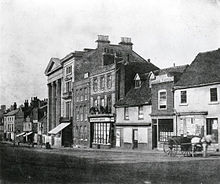This is an old revision of this page, as edited by JP22Wiki (talk | contribs) at 15:53, 23 October 2012 (→External links). The present address (URL) is a permanent link to this revision, which may differ significantly from the current revision.
Revision as of 15:53, 23 October 2012 by JP22Wiki (talk | contribs) (→External links)(diff) ← Previous revision | Latest revision (diff) | Newer revision → (diff)


Architectural photography is the photographing of buildings and similar structures that are both aesthetically pleasing and accurate representations of their subjects. Architectural photographers, are usually skilled in the use of specialized techniques and equipment.
History
The first permanent photograph, View from the Window at Le Gras by Nicéphore Niépce, was also the first architectural photograph as it was a view of buildings. Similarly, photographs taken by early photographer William Henry Fox Talbot were of architecture, including his photograph of a Latticed window in Lacock Abbey taken in 1835.
Throughout the history of photography, buildings have been highly valued photographic subjects, mirroring society's appreciation for architecture and its cultural significance. By the 1860s, architectural photography started to become an established visual medium.
Much as building designs changed and broke with traditional forms, architectural photography also evolved. During the early-to-mid-20th century, architectural photography became more creative as photographers used diagonal lines and bold shadows in their compositions, and experimented with other techniques.
By the early 1950s, architects were hiring more photographers for commissioned work, resulting in architectural photography being viewed as more of an art form.
Techniques
A tenet of architectural photography is the use of controlled perspective, with an emphasis on vertical lines that are non-converging (parallel). This is achieved by positioning the focal plane of the camera at so that it is perpendicular to the ground, regardless of the elevation of the camera eye. This result can be achieved by the use of view cameras, tilt/shift lenses, or post-processing.
Traditionally, view cameras have been used for architectural photography as they allow for the lens to be tilted or shifted relative to the film plane. This allows for control of perspective, as well as a variety of creative possibilities.
In a similar fashion to landscape photography, a deep depth of field is usually employed so that both the foreground and background (to infinity) are in sharp focus.
More recently, digital single lens reflex (DSLR) cameras have been used in the field of architectural photography. These cameras also employ detachable, tilt-shift lenses of varying (usually fixed) focal lengths.
Exterior and interior
Architectural photography is typically created from either the exterior views of buildings, or in the interior of buildings. The techniques used in each of these types of photography are similar, but do have some difference and sometimes require different equipment.
Exterior
Exterior architectural photography usually takes advantage of available daylight, or if performed at night, uses ambient light from adjacent street lights, landscape lights, exterior building lights, moonlight and even twilight present in the sky in all but the darkest situations.
In many cases, the landscaping surrounding a building is important to the overall composition of a photograph, and even necessary to communicate the aesthetic harmony of a building and its environment. An architectural photographer will often include flowers, trees, fountains or statues in the foreground of a composition, taking advantage of their ability to help lead the eye into the composition and to its main subject, the building.
Interior
Interior architectural photography can also be performed with ambient light transmitted through windows and skylights, as well as interior lighting fixtures. Frequently though, architectural photographers will use supplemental lighting to improve the illumination within a building. Either electronic flash "strobes" or incandescent "hot lights" can be used.
Trade organizations
The architectural photography profession is primarily represented by three trade organizations, which strive to spread best practices amongst architectural photographers, as well as promote the sound business practices, consistency, quality and copyright protection.
- The American Society of Media Photographers (ASMP)
- The Association of Independent Architectural Photographers (AIAP)
- The International International Association of Architectural Photographers (IAAP)
See Also
References
- Lowe, Jim (2006). Architectural Photography. Lewes, East Sussex, UK: Photographers Institute Press. ISBN 1-86108-447-1.
External links
- ASMP - American Society of Media Photographers - Architectural Photographers Group
- AIAP - The Association of Independent Architectural Photographers
- IAAP - International Association of Architectural Photographers
- Photography Talk - Architectural Photography Techniques